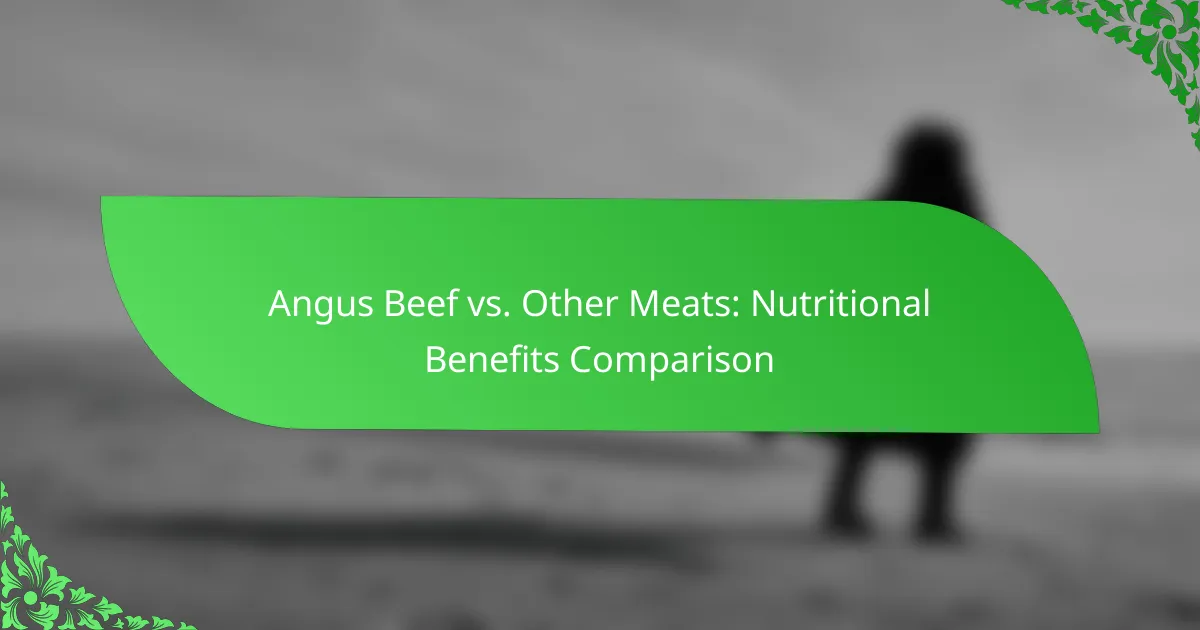When comparing Angus beef to other meats, it becomes clear that Angus beef stands out for its higher protein content and essential nutrients. While chicken is lower in fat, Angus beef offers a more favorable cholesterol profile and is richer in omega-3 fatty acids, making it a heart-healthy option. Additionally, Angus beef provides superior levels of zinc and other vital nutrients compared to turkey and pork, enhancing its appeal for those seeking a nutritious diet.

How does Angus beef compare to chicken in nutritional benefits?
Angus beef generally offers higher protein content and essential nutrients compared to chicken, making it a popular choice for those seeking to boost their protein intake. However, chicken is often lower in fat, which can be a consideration for those monitoring their fat consumption.
Higher protein content in Angus beef
Angus beef is known for its rich protein content, typically providing around 25-30 grams of protein per 100 grams. This makes it an excellent option for muscle building and repair, especially for athletes and active individuals. In contrast, chicken breast offers similar protein levels but may vary based on preparation methods.
When choosing between the two, consider your dietary goals. If you need a protein boost, Angus beef may be more beneficial, while chicken can still contribute significantly to your daily protein needs.
Lower fat content in chicken
Chicken, particularly skinless breast, is often lower in fat than Angus beef, with about 3-4 grams of fat per 100 grams compared to 15-20 grams in Angus beef. This lower fat content makes chicken a preferred choice for those looking to reduce fat intake or maintain a leaner diet.
For those concerned about heart health or weight management, opting for chicken can be a practical decision. However, the type of fat in Angus beef includes beneficial monounsaturated fats, which can also be part of a balanced diet.
Iron levels in Angus beef
Angus beef is a rich source of heme iron, which is more readily absorbed by the body compared to the non-heme iron found in plant sources. A serving of Angus beef can provide approximately 2-3 mg of iron per 100 grams, supporting energy levels and overall health.
For individuals at risk of iron deficiency, incorporating Angus beef into meals can be an effective strategy. Pairing it with vitamin C-rich foods can further enhance iron absorption.
Vitamin B12 in Angus beef
Angus beef is an excellent source of vitamin B12, essential for nerve function and red blood cell formation. A typical serving can deliver about 2-3 micrograms of B12, which is a significant portion of the daily recommended intake.
For those following a vegetarian or vegan diet, obtaining sufficient B12 can be challenging, making Angus beef a valuable option for those who consume meat. Regular consumption can help maintain optimal B12 levels, supporting overall health and vitality.

What are the health benefits of Angus beef over pork?
Angus beef offers several health benefits compared to pork, primarily due to its higher levels of essential nutrients and healthier fat composition. It is often richer in omega-3 fatty acids and has a more favorable cholesterol profile, making it a better choice for those focused on heart health.
Omega-3 fatty acids in Angus beef
Angus beef contains higher levels of omega-3 fatty acids compared to conventional pork. These beneficial fats are known for their anti-inflammatory properties and potential heart health benefits. Grass-fed Angus beef, in particular, can have significantly more omega-3s than grain-fed varieties.
Incorporating Angus beef into your diet can help increase your intake of these essential fatty acids, which are crucial for brain function and overall health. Aim for a balanced diet that includes sources of omega-3s, such as fatty fish and nuts, alongside Angus beef for optimal benefits.
Lower cholesterol levels in pork
Pork generally has a higher cholesterol content than Angus beef, which can be a concern for individuals managing their cholesterol levels. While lean cuts of pork can be part of a healthy diet, Angus beef tends to have a more favorable fat profile, particularly when choosing lean cuts.
When selecting meats, consider opting for lean Angus beef cuts like sirloin or tenderloin, which can provide protein without excessive cholesterol. Always check nutrition labels for specific cholesterol content to make informed choices.
Caloric differences between Angus beef and pork
The caloric content of Angus beef and pork can vary significantly based on the cut and preparation method. Generally, lean cuts of Angus beef may have a similar or slightly higher caloric content compared to lean pork cuts. However, the nutritional density of Angus beef often makes it a more satisfying option.
When planning meals, consider portion sizes and cooking methods. Grilling or broiling Angus beef can help retain its flavor while keeping calories in check. Aim for balanced meals that include vegetables and whole grains to complement the protein source.

How does Angus beef nutrition stack up against turkey?
Angus beef generally offers a richer nutritional profile compared to turkey, particularly in terms of zinc and protein content. While both meats are healthy options, Angus beef tends to provide higher levels of certain essential nutrients that can benefit overall health.
Higher zinc content in Angus beef
Angus beef is known for its higher zinc content, which is crucial for immune function, wound healing, and DNA synthesis. A typical serving of Angus beef can provide nearly double the zinc compared to turkey, making it a better choice for those looking to boost their zinc intake.
For individuals who require more zinc, such as pregnant women or those with certain health conditions, incorporating Angus beef into their diet can be particularly beneficial. This nutrient density can help meet daily requirements more efficiently.
Protein comparison between Angus beef and turkey
Both Angus beef and turkey are excellent sources of protein, but Angus beef typically contains more protein per serving. A standard serving of Angus beef can deliver around 25-30 grams of protein, while turkey offers about 20-25 grams.
This higher protein content in Angus beef can be advantageous for muscle building and repair, making it a preferred option for athletes or those engaged in strength training. Choosing Angus beef can help meet protein needs more effectively.
Fat content differences
When comparing fat content, Angus beef generally has a higher fat percentage than turkey, especially if choosing cuts like ribeye or T-bone. Angus beef can contain around 15-20 grams of fat per serving, while turkey, particularly lean cuts, may have as little as 1-5 grams.
While the fat in Angus beef includes both saturated and unsaturated fats, it’s important to consider portion sizes and overall dietary fat intake. For those monitoring fat consumption, opting for leaner cuts of Angus beef or balancing meals with turkey can help maintain a healthy diet.

What are the key nutritional attributes of Angus beef?
Angus beef is known for its rich flavor and high-quality nutritional profile, particularly in protein content and essential nutrients. It offers a balance of macronutrients and micronutrients that can support a healthy diet.
Protein per serving
Angus beef is an excellent source of protein, providing approximately 25-30 grams per 100 grams of cooked meat. This high protein content makes it a popular choice for those looking to build muscle or maintain a healthy weight.
When comparing Angus beef to other meats, such as chicken or pork, it often has a similar or slightly higher protein content. Choosing lean cuts can help maximize protein intake while minimizing fat consumption.
Essential vitamins and minerals
Angus beef is rich in essential vitamins and minerals, including iron, zinc, and B vitamins like B12 and niacin. These nutrients play vital roles in energy production, immune function, and red blood cell formation.
For example, a 100-gram serving of Angus beef can provide a significant portion of the daily recommended intake for iron, which is crucial for preventing anemia. Including Angus beef in your diet can help ensure you meet your nutritional needs effectively.
Caloric density
Angus beef tends to be calorie-dense, with around 250-300 calories per 100 grams, depending on the cut and fat content. This caloric density can be beneficial for those needing higher energy intake, such as athletes or individuals with physically demanding jobs.
However, it is essential to balance caloric intake with overall dietary goals. Opting for leaner cuts can help reduce calorie consumption while still providing the nutritional benefits of Angus beef.

How does the sourcing of Angus beef affect its nutritional value?
The sourcing of Angus beef significantly influences its nutritional value, primarily through the animal’s diet and farming practices. Grass-fed Angus beef typically contains higher levels of omega-3 fatty acids and antioxidants compared to grain-fed varieties, which may have a different fat profile and nutrient content.
Grass-fed vs. grain-fed Angus beef
Grass-fed Angus beef is raised on pasture, leading to a diet rich in natural grasses, which enhances its nutritional profile. This type of beef often has lower total fat content and higher concentrations of beneficial nutrients such as vitamin E and conjugated linoleic acid (CLA).
In contrast, grain-fed Angus beef is usually finished on a diet of grains, which can increase marbling and tenderness but may result in higher saturated fat levels. While grain-fed beef is often more widely available and less expensive, it may lack some of the health benefits associated with grass-fed options.
Impact of farming practices on nutrition
The farming practices employed in raising Angus cattle can greatly affect the nutritional quality of the meat. Organic and sustainable farming methods often prioritize animal welfare and natural diets, resulting in beef that is not only healthier but also free from antibiotics and hormones.
Conversely, conventional farming practices may involve the use of additives and feedlots, which can compromise the nutritional value of the beef. Consumers should consider looking for certifications such as USDA Organic or Certified Humane to ensure they are choosing Angus beef with superior nutritional benefits.

What are the environmental impacts of Angus beef compared to other meats?
Angus beef production has notable environmental impacts, particularly in terms of carbon emissions and water usage, which can vary significantly when compared to other meats like chicken or pork. Understanding these factors is essential for making informed dietary choices.
Carbon footprint of Angus beef
The carbon footprint of Angus beef is generally higher than that of poultry and pork, primarily due to the methane emissions produced by cattle during digestion. Estimates suggest that beef can contribute several times more greenhouse gases per kilogram than chicken or plant-based proteins.
When considering the carbon impact, it’s important to note that factors such as farming practices, feed types, and land use can influence overall emissions. Sustainable practices, like rotational grazing, can help mitigate some of these effects.
Water usage in Angus beef production
Water usage in Angus beef production is substantial, with estimates indicating that producing one kilogram of beef may require thousands of liters of water. This includes water for drinking, feed crops, and processing, making beef one of the most water-intensive meats.
In contrast, chicken and pork typically require significantly less water per kilogram produced. To reduce water consumption, consumers might consider incorporating more plant-based proteins or choosing meats with lower water footprints.
